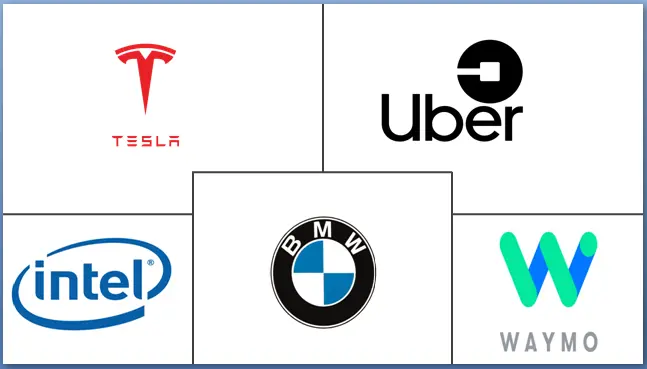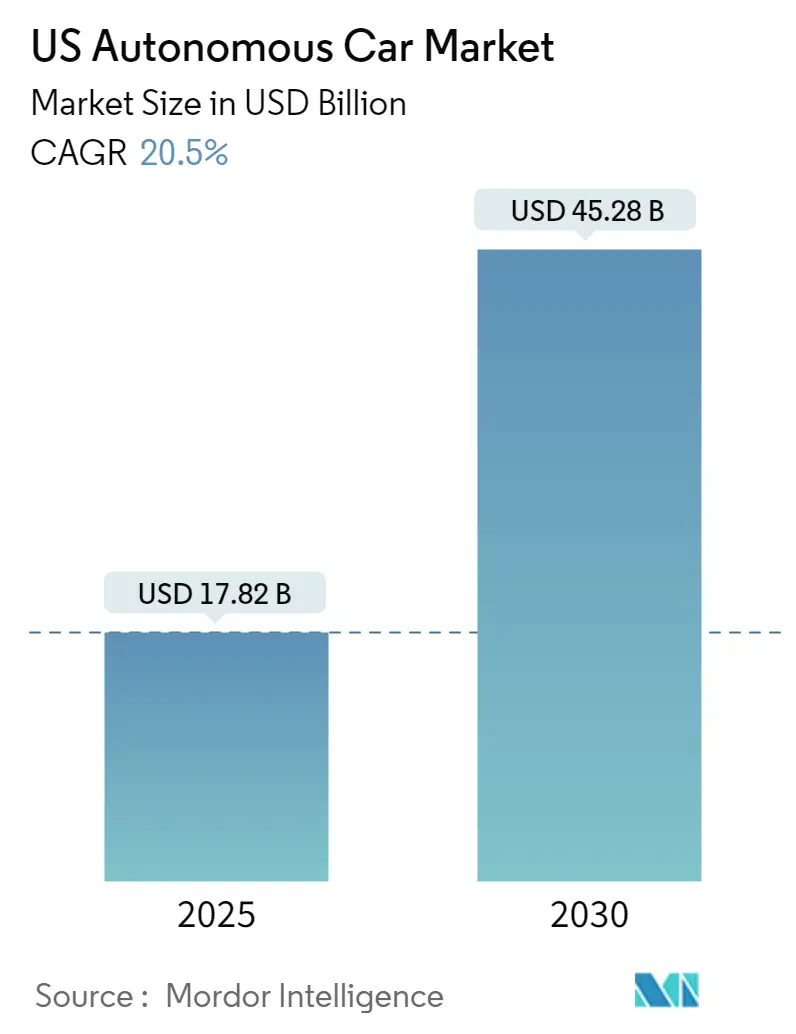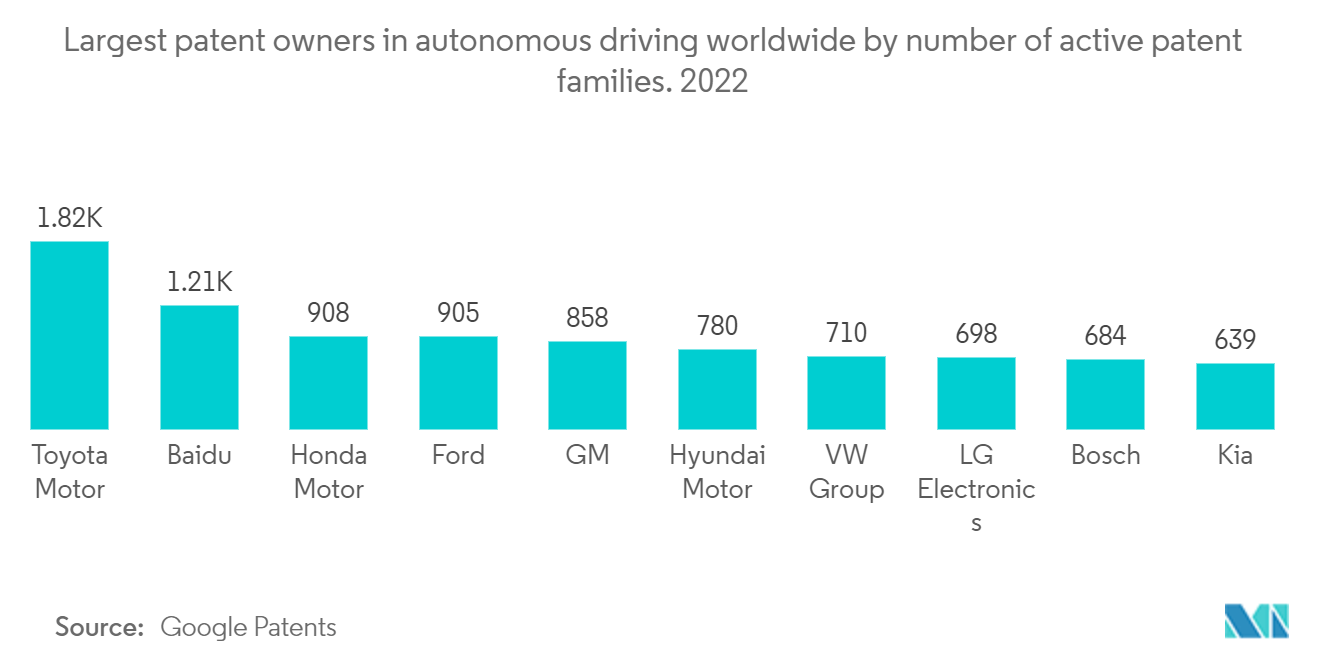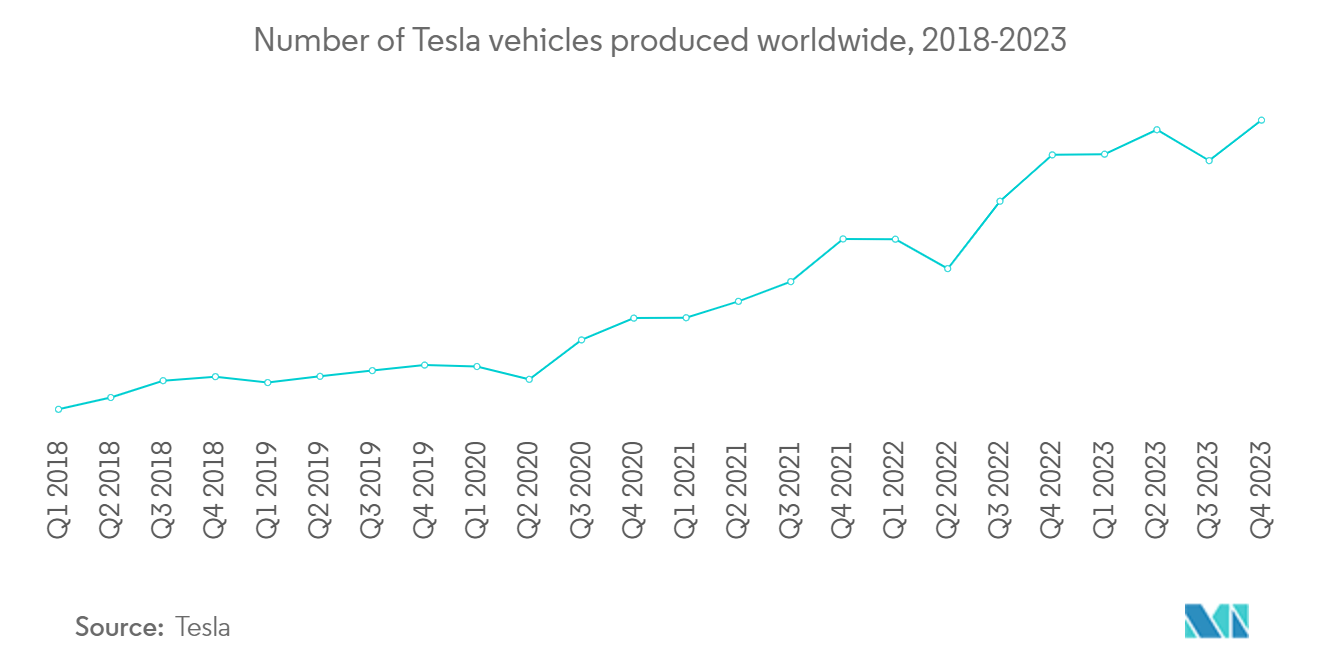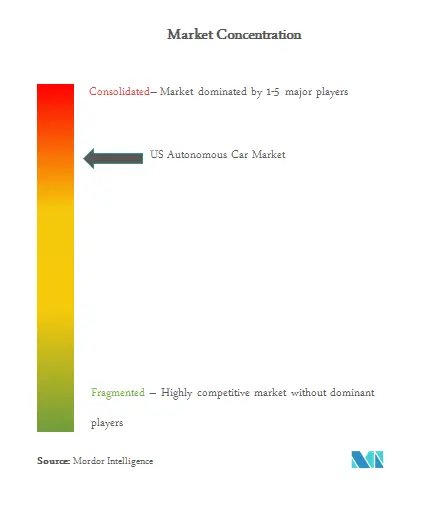US Autonomous Vehicle Market Size
US Autonomous Vehicle Market Analysis
The US Autonomous Car Market size is estimated at USD 17.82 billion in 2025, and is expected to reach USD 45.28 billion by 2030, at a CAGR of 20.5% during the forecast period (2025-2030).
Over the medium term, with stringent regulations by the government focused on improving road safety, more autonomous vehicles are being developed with highly advanced technologies integrated with smartphones, creating new interest among market players to attract customers. Due to rising health concerns and changing commuting patterns, the demand for personal cars among private consumers is also increasing. According to Euromonitor's Voice of the Industry survey, 13% of respondents indicated they plan to permanently increase the usage of cars for commuting short distances.
Level 4 and Level 5 (as scaled by the SAE) autonomous cars may not reach wide acceptance by 2030. However, there would be rapid growth for Level 2 and Level 3 autonomous cars, which have advanced driver assistance systems, like collision detection, lane departure warning, and adaptive cruise control.
The demand for self-driving cars in the United States has increased significantly over the past few years. The demand is well supported by collaborations between companies across the United States. For instance,
- In September 2023, Mercedes-Benz introduced the Mercedes-Benz Drive Pilot, a certified SAE Level 3 system, in the United States. This system manages dynamic driving tasks, allowing drivers to focus on other activities. The Drive Pilot system includes multiple sensors such as lidar, a rear camera, and microphones for detecting emergency vehicles.
- In May 2023, Uber and Alphabet partnered to launch autonomous vehicle services for trips and deliveries in Phoenix, Arizona.
Apart from these developments, Mexico's new trade agreement with the United States and Canada involves opportunities for the transfer of autonomous technology. However, there is room for improvement in infrastructure in the coming years.
US Autonomous Vehicle Market Trends
Growing Adoption of Semi-autonomous Cars is Expected to Drive Market Demand
The US autonomous car market is expected to be dominated by semi-autonomous cars, as the need for ease in driving and the increasing concern for safety and security are boosting the demand for high-end technology.
The contributing factors to the market’s growth are the need for safe and efficient driving options, evolution in connected car technology, increasing R&D in the autonomous car industry, and government support for these cars in terms of policies and rebates.
According to the NHTSA (National Highway Traffic Safety Administration), about 94% of the accidents occurring on US roadways can be attributed to human errors, like drunken driving and speeding. These can be mitigated with an autonomous car, whose functionality may follow the speed regulations stated in particular areas. In December 2023, the US Department of Transportation announced USD 25 million in funding for research applications on rural autonomous vehicles. Accredited universities can apply for this highly competitive six-year joint partnership program.
The market is expected to grow due to the rapid digitization of connected cars, which adds to their demand. The two necessary components of vehicle autonomy (vehicle-to-vehicle and vehicle-to-infrastructure connectivity) can be more easily integrated into connected cars than conventional ones.
The OEMs’ competitive rivalry has led to significant developments in this technology that cater to the ever-increasing demand from the public. For instance, over a few months in 2021, Tesla released a Fully Self Driving (FSD) over-the-air (OTA) update to a majority of its vehicle owners, leading to the adoption of fully autonomous vehicles.
Various startups working with Level 4 cars are getting new funding to accelerate their operations. For instance,
- In January 2024, Waymo announced its plans to deploy its vehicles on the Phoenix freeway without a safety driver for the first time. The company also offers autonomous ride-hailing services within a 63-square-mile area of Los Angeles.
- Amazon's USD 1 billion venture capital fund was set to expand its investment portfolio in January 2024, focusing on last-mile technology and autonomous vehicle industries.
- To enhance testing in Las Vegas, Zoox, an Amazon subsidiary focused on self-driving cars, announced plans to hire additional employees in June 2023 despite regulatory concerns affecting the advancement of autonomous car technology.
Owing to such intense competitive rivalry and other factors involving different types of vehicle automation, the demand for fully autonomous vehicles in the United States is expected to witness significant growth during the forecast period.
Demand for Conditional Automation is Expected to Grow Over the Forecast Period
By level of automation, the US autonomous car market is dominated by conditional automation (Level 3). In Level 3 automation, the autonomous vehicle driving system performs all the dynamic driving tasks, expecting the human driver to respond appropriately to the request to intervene. The dynamic driving task includes steering, braking, accelerating, monitoring the vehicle, and responding to events happening on the road.
Self-driving cars have already been tested and used in California, Texas, Arizona, Washington, Michigan, and other states. However, their mobility is restricted to specific test areas and driving conditions. Audi was the first company to develop a Level 3 autonomous car by launching the Audi A8 in the market. However, there are a few limitations for Level 3 autonomous cars, such as constant awareness needed from the driver. Thus, this makes Level 3 automation less dependable.
Mercedes-Benz was the first automaker to implement SAE Level 3 autonomous driving in the United States in January 2023, following state laws in Nevada. By April 2024, Mercedes-Benz had sold 65 autonomous vehicles in California. The Drive Pilot system, featuring Level 3 autonomy, is available in the S-Class and EQS Sedans. Additionally, in January 2024, Mercedes-Benz received permission to use specific external lights for automated driving in Nevada and California.
Consequently, several automotive manufacturers are pushing directly for Level 3 autonomous cars, and various technology companies in the country are reaching new milestones in terms of total miles tested. Such developments across the United States are expected to drive demand in the market.
US Autonomous Car Industry Overview
The US autonomous car market is consolidated and dominated by a few players, such as Apple, Waymo, Tesla, Ford, Honda, BMW, Nissan, Intel, and Uber. These players have also encompassed brand reinforcement, innovation, collaboration, and M&A strategies to gain a higher competitive share. For instance,
- In January 2024, TIER IV, a provider of open-source autonomous driving technology, introduced the Co-MLOps (Cooperative Machine Learning Operations) project. This initiative aims to speed up AI development for autonomous driving. The deployment of the Co-MLOps Platform will facilitate the global exchange of managed sensor data, such as camera images and lidar point clouds, from various regions. TIER IV demonstrated AI models at CES 2024 in Las Vegas, which may positively influence the future of autonomous vehicles in the United States.
- In July 2023, Volkswagen launched its first autonomous vehicle test pilot in Austin, United States. The pilot involved 10 all-electric IDs. Buzz vehicles are equipped with an autonomous driving technology platform developed in collaboration with Mobileye. These efforts are contributing to the growth of the US autonomous vehicle market.
- In June 2023, Kia, a South Korean carmaker, announced the launch of its all-electric EV9 flagship SUV in the United States. The EV9 features a 99.8 kWh battery, capable of traveling approximately 501 km on a single charge. The GT-line model will also include Level 3 autonomous driving technology with a Highway Driving Pilot program.
US Autonomous Car Market Leaders
-
Waymo
-
Tesla
-
BMW
-
Intel
-
Uber
- *Disclaimer: Major Players sorted in no particular order
US Autonomous Car Market News
- May 2024: Volvo Autonomous Solutions showcased an autonomous truck at the ACT Expo in Las Vegas. The truck featured autonomous driving technology from Aurora Innovation, including high-resolution cameras, imaging radar, patented lidar capable of detecting objects up to 400 meters away, AI algorithms, dual computers, and additional sensors.
- February 2024: Oxa, a company specializing in autonomous vehicles, introduced a commercial self-driving bus in Florida. The Oxa driver software will support the driverless service in the United States, which is operated by American shuttle provider Beep in collaboration with the Jacksonville Transport Authority and Florida State College at Jacksonville.
- January 2024: TIER IV, a provider of open-source autonomous driving technology solutions, launched the Co-MLOps (Cooperative Machine Learning Operations) project. This initiative aims to accelerate the development of AI for autonomous driving.
US Autonomous Vehicle Industry Segmentation
An autonomous car can sense its environment and move with little or no human input. Autonomous vehicles are made up of numerous sensors, such as lidar and radar systems, working concurrently to carry out operations automatically or without the help of drivers. The US autonomous car market report covers the latest trends and COVID-19 impact, followed by technological developments.
The report's scope is segmented by type, sensors, and level of automation. The market is segmented by type into fully autonomous and semi-autonomous vehicles. By sensors, the market is segmented into the image, lidar, radar, ultrasonic, and other sensors.
By level of automation, the market is segmented into conditional automation (Level 3), high automation (Level 4), and full automation (Level 5)). For each segment, market sizing and forecasts are based on value (USD).
| Type | Fully Autonomous Vehicles |
| Semi-autonomous Vehicles | |
| Sensors | Radar |
| Lidar | |
| Ultrasonic | |
| Other Sensors | |
| Level of Automation | Conditional Automation (Level 3) |
| High Automation (Level 4) | |
| Full Automation (Level 5) |
| Fully Autonomous Vehicles |
| Semi-autonomous Vehicles |
| Radar |
| Lidar |
| Ultrasonic |
| Other Sensors |
| Conditional Automation (Level 3) |
| High Automation (Level 4) |
| Full Automation (Level 5) |
US Autonomous Car Market Research FAQs
How big is the US Autonomous Car Market?
The US Autonomous Car Market size is expected to reach USD 17.82 billion in 2025 and grow at a CAGR of 20.5% to reach USD 45.28 billion by 2030.
What is the current US Autonomous Car Market size?
In 2025, the US Autonomous Car Market size is expected to reach USD 17.82 billion.
Who are the key players in US Autonomous Car Market?
Waymo, Tesla, BMW, Intel and Uber are the major companies operating in the US Autonomous Car Market.
What years does this US Autonomous Car Market cover, and what was the market size in 2024?
In 2024, the US Autonomous Car Market size was estimated at USD 14.17 billion. The report covers the US Autonomous Car Market historical market size for years: 2019, 2020, 2021, 2022, 2023 and 2024. The report also forecasts the US Autonomous Car Market size for years: 2025, 2026, 2027, 2028, 2029 and 2030.
Our Best Selling Reports
US Autonomous Vehicle Industry Report
Statistics for the 2025 US Autonomous Car market share, size and revenue growth rate, created by Mordor Intelligence™ Industry Reports. US Autonomous Car analysis includes a market forecast outlook for 2025 to 2030 and historical overview. Get a sample of this industry analysis as a free report PDF download.

